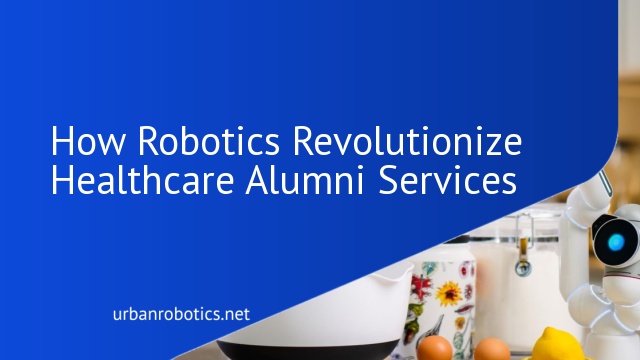Overview of Healthcare Alumni Services
Healthcare alumni services play a crucial role in maintaining connections between healthcare institutions and their graduates. These services ensure alumni stay updated with the latest advancements, engage in continuous learning, and contribute to their field’s development. They provide a platform for professionals to share knowledge, research, and innovations, ultimately enhancing patient care standards.
Key components of healthcare alumni services include educational programs, networking opportunities, and mentorship programs. Educational programs (e.g., seminars, workshops) help alumni stay abreast of new medical technologies and practices. Networking opportunities (e.g., conferences, online forums) enable alumni to forge connections with peers, fostering a collaborative environment. Mentorship programs pair experienced professionals with recent graduates, promoting knowledge transfer and career growth.
Robotics is transforming these services by automating administrative tasks, enhancing online learning experiences, and facilitating virtual networking events. Automated systems manage alumni databases (e.g., contact information, professional achievements) efficiently, allowing institutions to focus on strategic initiatives. Online learning platforms, powered by robotics, offer interactive and immersive educational experiences, making learning more accessible and engaging. Virtual networking, supported by advanced robotics, provides seamless communication, overcoming geographical barriers and connecting alumni globally.
The Role of Robotics in Healthcare
Robotics is revolutionizing the healthcare industry, offering innovative solutions for patient care and alumni services. These advancements bridge patients with medical professionals and enhance how alumni connect and learn.
Types of Robotics in Healthcare
Robots encompass a range of applications within healthcare. Surgical robots perform precise procedures, reducing recovery times. Rehabilitation robots aid in physical therapy, helping patients regain mobility. Telepresence robots allow remote consultations, offering access to specialists worldwide. Supply robots manage logistics, delivering medications and supplies throughout hospitals, improving operational efficiency.
Benefits of Robotics in Healthcare
Robotics offers numerous benefits in healthcare. Robots enhance precision and accuracy in surgeries, leading to better patient outcomes. Automation of repetitive tasks reduces human error and increases efficiency. They enable remote care, making healthcare accessible even in remote areas. This technology also ensures consistent and reliable performance, minimizing variations in care delivery. By integrating robotics, healthcare becomes more effective and patient-centered.
Integration of Robotics into Alumni Services
Robotics plays a pivotal role in enhancing healthcare alumni services. Leveraging advanced technologies, we connect alumni for continuous education, networking, and professional development.
Key Technologies Utilized
Robotics in alumni services employs various technologies for effective interactions. Telepresence robots enable virtual attendance at conferences and meetings. AI-driven bots assist in data management, ensuring personalized alumni experiences. Robotic simulation platforms allow alumni to engage in remote medical training. Each technology elevates the quality and accessibility of our alumni services.
Case Studies and Examples
Several institutions have successfully integrated robotics into their alumni services. At Johns Hopkins University, telepresence robots enable alumni to participate in global health conferences. The Mayo Clinic uses AI bots to manage alumni data, enhancing networking opportunities. At Stanford University, robotic simulation platforms facilitate hands-on training for alumni, keeping their skills current. These examples demonstrate how robotics can revolutionize our alumni services.
Challenges and Considerations
Robotics in healthcare alumni services offers numerous benefits, but we must address several challenges to fully realize its potential.
Ethical and Privacy Concerns
Implementing robotics raises significant ethical and privacy concerns. Alumni data collected by AI-driven systems require stringent data protection measures. It’s essential to ensure that data handling adheres to regulations like HIPAA and GDPR. Transparent data usage policies and robust cybersecurity measures can help address these concerns and build trust among alumni.
Cost and Accessibility Issues
Investing in robotics technology can be expensive, posing a significant barrier for smaller institutions. High initial setup costs and maintenance fees can limit access to advanced robotic systems. Exploring partnerships and funding opportunities can help alleviate financial burdens. Ensuring equitable access to robotics-enhanced services will allow all alumni to benefit, regardless of the institution’s size or resources.
Future of Healthcare Alumni Services with Robotics
The integration of robotics into healthcare alumni services continues to evolve. We see several trends emerging and their potential impact on education and training.
Emerging Trends
Robotics is revolutionizing healthcare alumni services. The use of telepresence robots, AI-driven bots, and robotic simulators is increasing. Universities and institutions are now offering virtual seminars and workshops. Alumni can attend these events regardless of location. AI bots are being used to deliver personalized newsletters and updates. These technologies enhance the engagement and reach of alumni services.
Potential Impact on Education and Training
Robotics has a significant impact on healthcare education and training. Simulated robotic surgeries provide hands-on training without patient risk. Medical alumni can access remote training sessions, expanding their skillsets. AI-driven tools offer personalized learning paths. This helps alumni stay updated with the latest medical advancements. Robotics fosters continuous professional development, ensuring alumni remain competitive in their field.
Conclusion
The integration of robotics into healthcare alumni services is transforming the landscape of medical education and professional development. By leveraging telepresence robots AI-driven bots and robotic simulation platforms we’re able to offer alumni innovative ways to stay connected and up-to-date with the latest advancements in healthcare. These technologies provide personalized experiences and remote training opportunities that are crucial for continuous learning and skill enhancement.
While challenges like ethical concerns and high costs exist our proposed strategies aim to ensure equitable access and secure use of these advanced tools. Embracing robotics in healthcare alumni services not only enhances the quality of patient care but also strengthens the professional community by fostering ongoing development and collaboration. Let’s continue to explore and adopt these technologies to build a more connected and proficient healthcare workforce.





